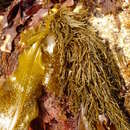en
names in breadcrumbs


Analipus japonicus, or sea fir, is a brown alga species in the genus Analipus.
This species contains the phlorotannins difucol, trifucol, tetrafucol A and B, two pentafucols, four hexafucols, a heptafucol mixture and halogenated compounds such as bromo- and chlorotrifucol, 5'-bromo- and 5'-chlorotetrafucol-A as well as 5'-bromo- and 5'-chloropentafucol-A.[1]
This brown alga species is a Pacific subtropical-boreal plant species that populates the stone coast from the Sea of Japan to the Bering Sea and from Alaska to California. The Analipus thallus is an abiding lobed basal crust ("tar spot"), from which a short lived vertical axis with a number of branches develop. From the branches develop a unilocular or multilocular sporangia advance on the branches.[2]
Analipus japonicus, or sea fir, is a brown alga species in the genus Analipus.
This species contains the phlorotannins difucol, trifucol, tetrafucol A and B, two pentafucols, four hexafucols, a heptafucol mixture and halogenated compounds such as bromo- and chlorotrifucol, 5'-bromo- and 5'-chlorotetrafucol-A as well as 5'-bromo- and 5'-chloropentafucol-A.
This brown alga species is a Pacific subtropical-boreal plant species that populates the stone coast from the Sea of Japan to the Bering Sea and from Alaska to California. The Analipus thallus is an abiding lobed basal crust ("tar spot"), from which a short lived vertical axis with a number of branches develop. From the branches develop a unilocular or multilocular sporangia advance on the branches.
Analipus japonicus est une espèce d’algues brunes de la famille des Ralfsiaceae selon AlgaeBase (311 mars 2019)[3] et NCBI (11 mars 2019)[4], ou de celle des Chordariaceae selon ITIS (11 mars 2019)[5] ou encore de celle des Scytosiphonaceae selon World Register of Marine Species (11 mars 2019)[6].
Cette algue présente une base pérenne encroûtée, d'où poussent, dès le mois de Mars, des thalles érigés qui eux sont annuels.
Cette espèce a reçu plusieurs appellations synonymes. Son basionyme est Halosaccion japonicum Harvey, 1857 ; et elle a deux synonymes hétérotypiques : Chordaria abietina Ruprecht ex Farlow, 1875 et Heterochordaria abietina (Ruprecht ex Farlow) Setchell et Gardner, 1924.
Analipus japonicus est une espèce d’algues brunes de la famille des Ralfsiaceae selon AlgaeBase (311 mars 2019) et NCBI (11 mars 2019), ou de celle des Chordariaceae selon ITIS (11 mars 2019) ou encore de celle des Scytosiphonaceae selon World Register of Marine Species (11 mars 2019).